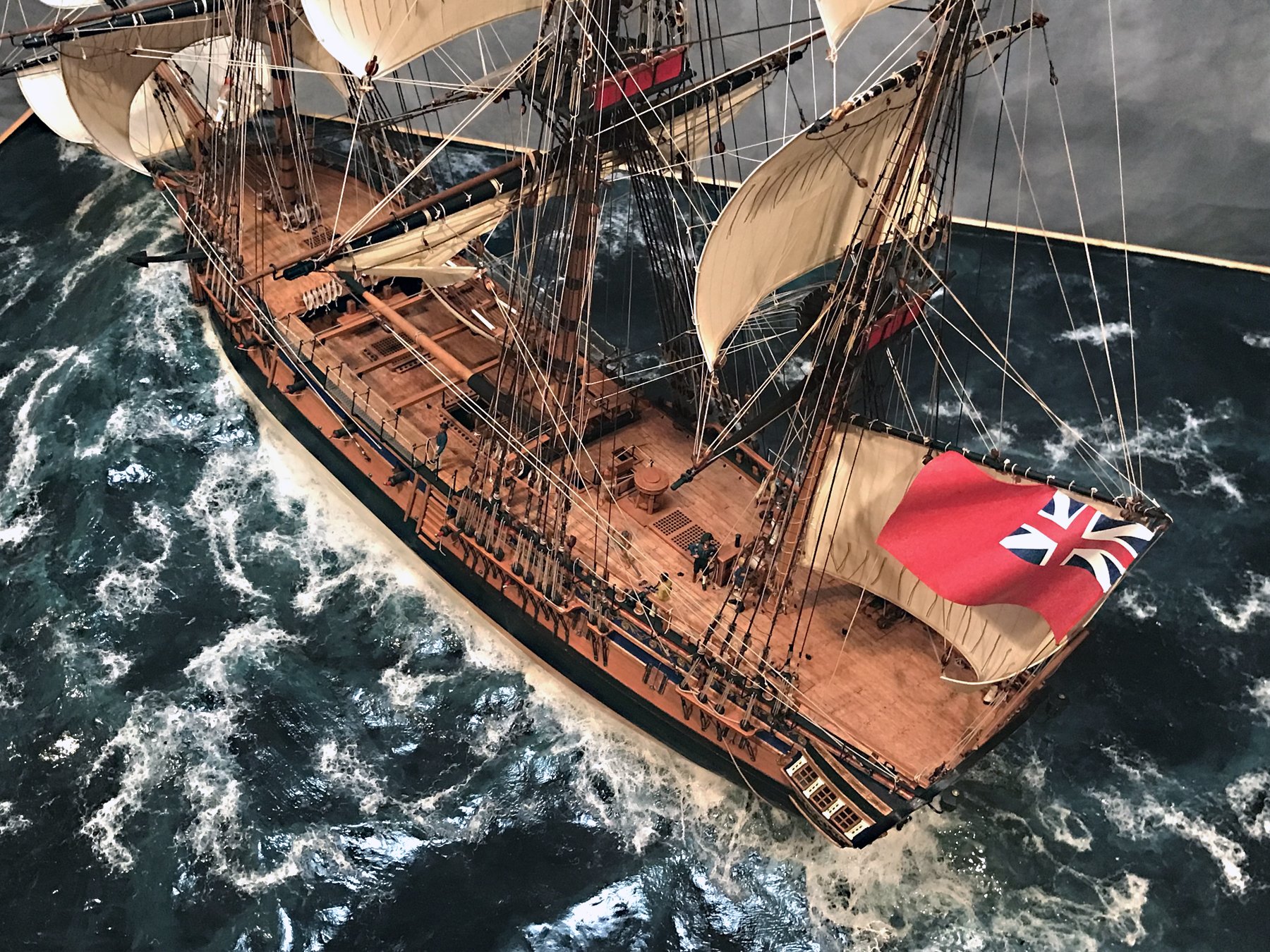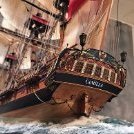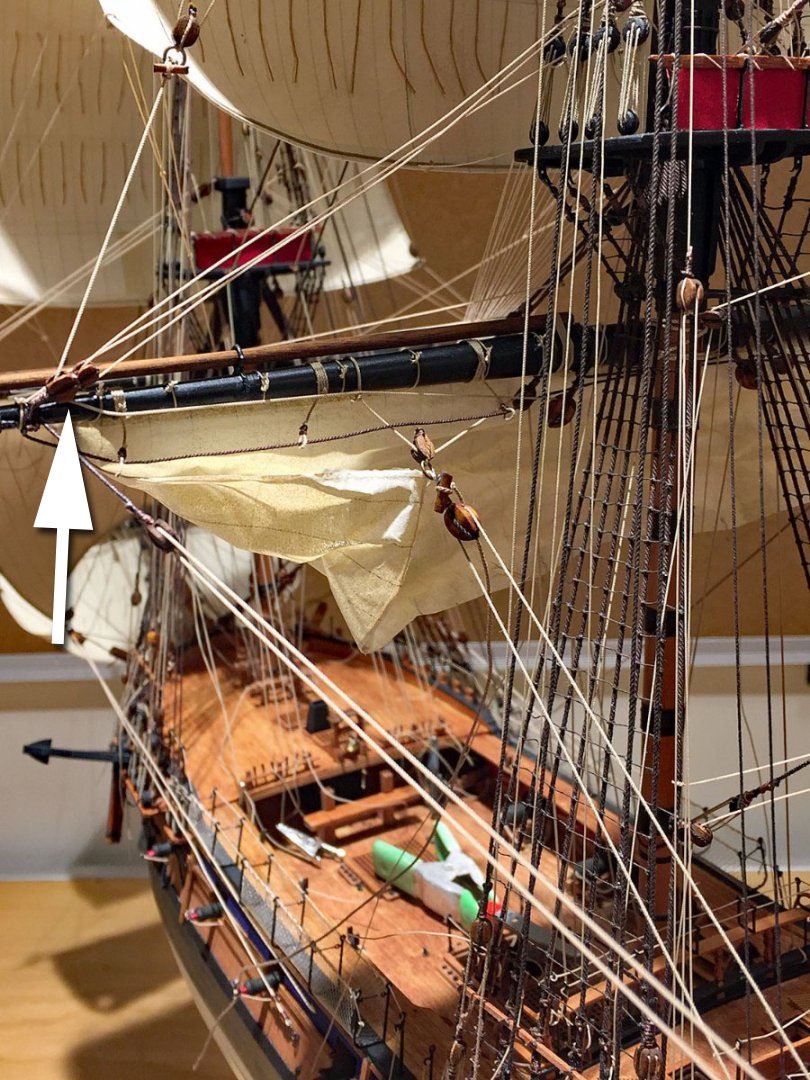-
Posts
1,589 -
Joined
-
Last visited
Content Type
Profiles
Forums
Gallery
Events
Everything posted by hollowneck
-
Bill, To my knowledge there are only three (small) sizes of these properly-shaped "violin blocks" (double blocks) available from Syren Ship Models. There may be others available but I have yet to discover other quality sources. Here's a link: (https://syrenshipmodelcompany.com/boxwood-rigging-blocks.php#!/New-improved-9-32-7mm-Boxwood-Fiddle-block-Laser-Cut-Kit-Build-it-yourself/p/39688217/category=5764703 If the scale you need can't be found among these three options, then I believe you'll need to scratch them, which could be a Big Pain with lots of delicate carving involved. In the photo below my arrow points to the Syren Fiddle Blocks I used on a recent model. These accurately fashioned blocks are made from boxwood; I stain them a reddish hue to simulate Chestnut, a typical wood used for rigging blocks for centuries. As you can see, all the other blocks in the photo are the same color (excepting the upper deadeyes). In this photo, located near the tip of a main course yardarm, the violin block works to lift the yardarm (inner, small part) and the larger part (outer) guides a main topsail's tack control rope. Hope this helps! (but humbled apologies if you know all this info already).
-
In my experience, Chris' provisions for comprehensive rigging plans started with hand drafted ones with Caldercraft kits of decades past and continued on with the Amati/Victory range. Every Vanguard kit I've tackled (three, thus far) have superlative, clearly-delineated, large-scale plans. What a pleasure for those who go the "whole nine yards" (and possibly, then some!). P.S. I really like the blue/grey hue you created for the Captain's quarters... and, nice move to paint the cabin's beam facia in nicely reflective white too.
- 648 replies
-
- Indefatigable
- Vanguard Models
-
(and 1 more)
Tagged with:
-
This is where us model builders need to think like Age of Sail bosuns, a term I think essentially connotes a "ship's onboard engineer." I continue to encounter (and, hopefully, successfully resolve) the problem of where running rigging lines get terminated, particularly working sail lines since I add these to most of my models. Very few kits provide sail plans; trying to figure out where these additional lines terminated can be a challenge - even after doing research in available references like Lee's, etc. I've typically solved these termination issues with a the addition of a knowledge of physics, plane geometry, and mostly, common sense. I have also sailed a bit and this helps resolve the occasional conundrum. My approach confirms a truth that in addition to being the captain's of our own modeling decisions; The Devil Remains In the Details. Good deciphering, B.E. Your Indy is looking good, very good indeed. May the skylight be moved, the bitts be shifted and The Force Be With You.
- 648 replies
-
- Indefatigable
- Vanguard Models
-
(and 1 more)
Tagged with:
-
Very stately environs it must be said. Have you thought about adding to the Captain's tabletop the "lesser of two weevils?"
- 648 replies
-
- Indefatigable
- Vanguard Models
-
(and 1 more)
Tagged with:
-
To my eyes, the crease marks remain quite visible even with all the other elements to look at: tiny touches of flat black acrylic paint applied with a small brush to touch-up the squares will work a treat.
- 648 replies
-
- Indefatigable
- Vanguard Models
-
(and 1 more)
Tagged with:
-
Rob, My procedure is to completely fabricate all the masts, main to topgallants and then start the rigging. Carefully evaluate what rigging hardware needs to be attached to the mast components; for example, all the blocks under the tops, on the crosstrees, the blocks for the stays and preventers to the main & mizzen, etc. Vanguard plans for this phase are excellent and you will have plenty of details to follow. This process can be a complicated one (understatement). I use a red marker to check off each item on the plans once completed. Nice job on your Hornblower & Pellew. Removing the base on them is a tricky business; a combo of hand cutters and sanding. Proceed very slowly. It's all too easy for either (or both) of them to end up with a prosthetic leg in this process. To fully rig this model will take you approximately as long as it took for you to build her hull; that's a rule-of-thumb I advise beginning modelers of square rigs. Great job!
-
B.E., I’m sure you’ve considered planking one side only on the Q’deck (and on the foc’sle when you head to the bows). For an admiralty-styled presentation, I’d find this “half-planked” solution credible - and an interesting view.
- 648 replies
-
- Indefatigable
- Vanguard Models
-
(and 1 more)
Tagged with:
-
I suspect cell-phone wide angle lens distortion. Is this a credible supposition, B.E? Nice stanchion metalwork. She’s coming together beautifully.
- 648 replies
-
- Indefatigable
- Vanguard Models
-
(and 1 more)
Tagged with:
-
Nope, it disappeared in the early 21st century here in the Wild West... We now have Amazon Prime: express, same-day delivery - as long as you order in the AM...
- 648 replies
-
- Indefatigable
- Vanguard Models
-
(and 1 more)
Tagged with:
-
I'm also envisioning more than one hundred pressed sailors (not including the "powder monkeys"), scurrying about on that deck to handle the guns! Whilst peering thro' various gunports on close inspection with my high-intensity LED mini flashlight, it will be quite impressive to see all these well-crafted smashers, that I may completely overlook that none have their breeching ropes or tackle...
- 648 replies
-
- Indefatigable
- Vanguard Models
-
(and 1 more)
Tagged with:
-
Poor fellows, CW & BE: two days expected delivery in the U.K. In the American colonies it could be two WEEKS.
- 648 replies
-
- Indefatigable
- Vanguard Models
-
(and 1 more)
Tagged with:
-
The increased height of the coamings look good. With more seawater and rain washing over the deck this makes very good sense. The gratings look nice too with the increased camber.
- 648 replies
-
- Indefatigable
- Vanguard Models
-
(and 1 more)
Tagged with:
-
B.E. Your choice of stain for the boxwood looks good to my eye: the "ochre" scheme you've chosen appears spot-on. There can be a wide variance of hue with the principal fruitwoods that we use for our models. Even when all the wood is cut from the same billet, there can be color variances ranging from subtle to dramatic; I typically sort planking strips into similar hues whether furnished in a kit or bashed with replacement hardwoods.
- 648 replies
-
- Indefatigable
- Vanguard Models
-
(and 1 more)
Tagged with:
-
A-ha! I saw the planking pattern and assumed it was the one piece approach. Superb work on making your own Top & Butt planking, a very nice touch.
- 648 replies
-
- Indefatigable
- Vanguard Models
-
(and 1 more)
Tagged with:
-
Very nice second planking job, B.E. An especially good job on conforming the one-piece wale. She's looks just about ready for her ball evening gown (stain & WOP finish)...
- 648 replies
-
- Indefatigable
- Vanguard Models
-
(and 1 more)
Tagged with:
-
Your small flotilla of Moby Dick chasing whaleboats look great, Good Job! Don't forget the tholes on the boats (oarlocks).
- 200 replies
-
- Whaling Bark
- Charles W Morgan
-
(and 1 more)
Tagged with:
-
Glenn. If interested, I can show you how to put her in an invisible seascape.
- 840 replies
-
- winchelsea
- Syren Ship Model Company
-
(and 1 more)
Tagged with:
-
B.E. I just broke off two of the beautiful, curvy gunport bulwarks on my Vanguard Grecian. Grrrrrrrrrr. I had glued and clipped them carefully and then whilst placing the hull back into my keel clamper, I bumped two of the projecting small clamps and bits fell to the shop floor. An easy fix however. These attractive design elements will draw eyeballs but also attract careless fingers! Sorry: no photographic evidence of this cock-up!
- 648 replies
-
- Indefatigable
- Vanguard Models
-
(and 1 more)
Tagged with:
About us
Modelshipworld - Advancing Ship Modeling through Research
SSL Secured
Your security is important for us so this Website is SSL-Secured
NRG Mailing Address
Nautical Research Guild
237 South Lincoln Street
Westmont IL, 60559-1917
Model Ship World ® and the MSW logo are Registered Trademarks, and belong to the Nautical Research Guild (United States Patent and Trademark Office: No. 6,929,264 & No. 6,929,274, registered Dec. 20, 2022)
Helpful Links
About the NRG
If you enjoy building ship models that are historically accurate as well as beautiful, then The Nautical Research Guild (NRG) is just right for you.
The Guild is a non-profit educational organization whose mission is to “Advance Ship Modeling Through Research”. We provide support to our members in their efforts to raise the quality of their model ships.
The Nautical Research Guild has published our world-renowned quarterly magazine, The Nautical Research Journal, since 1955. The pages of the Journal are full of articles by accomplished ship modelers who show you how they create those exquisite details on their models, and by maritime historians who show you the correct details to build. The Journal is available in both print and digital editions. Go to the NRG web site (www.thenrg.org) to download a complimentary digital copy of the Journal. The NRG also publishes plan sets, books and compilations of back issues of the Journal and the former Ships in Scale and Model Ship Builder magazines.








